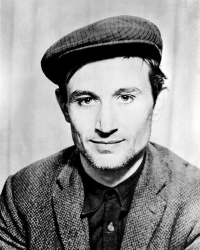İbrahim Kaypakkaya
İbrahim Kaypakkaya | |
|---|---|
 | |
| Born | 1949 |
| Died | May 18, 1973 (aged 23–24) Diyarbakır, Turkey |
| Cause of death | Torture |
| Resting place | Karakaya Cemetery, Çorum |
| Nationality | Kurdish |
| Education | Istanbul University |
| Years active | 1967-1973 |
| Political party | Communist Party of Turkey/Marxist–Leninist |
| Movement | Marxism–Leninism–Maoism |
| Parent(s) | Ali Kaypakkaya (father) Mediha Kaypakkaya (mother) |
İbrahim Kaypakkaya (1949 – May 18, 1973) was a
Life
Ibrahim Kaypakkaya was born in 1949 to a Turkish
Kaypakkaya, who adopted the view of National Democratic Revolution, worked for the newspaper İşçi Köylü ("Worker-Peasant"). He wrote articles in the magazines
Kaypakkaya and his comrades interrogated and shot the informer village headman who caused the killing of THKO (Turkish: Türkiye Halk Kurtuluş Ordusu; "People's Liberation Army of Turkey") members Sinan Cemgil and his two other comrades by the state forces during a gunfight. Kaypakkaya became a symbol of revolutionary solidarity and camaraderie to his supporters during the period of martial law.[citation needed]
Capture and death
Following the
The Turkish Government persecuted and destroyed the leadership of the TKP/ML. Kaypakkaya, and several of his colleagues were arrested. On 18 May 1973, he was tortured to the brink of death and then shot and killed by military officers at the age of twenty-four. His corpse was mutilated and cut up.[9] The cause of Kaypakkaya's death was ruled as a suicide.[10]
The
Aftermath
- Cafer Atan, the teacher who allegedly handed over Kaypakkaya to the gendarmerie, frequently changed his place of duty for life safety reasons. Atan was shot in the head and killed, in front of his wife and two children, by three people who raided his house in Sarıgazi in 2000.[12]
- Fehmi Altınbilek, who led the commando operation against Kaypakkaya and his friends on January 24, 1973, and later captured Kaypakkaya wounded, was injured in an armed attack in Beşiktaş in June 2015.[13]
Cultural legacy
After his death, Kaypakkaya became a martyr for the Turkish Communist revolutionary movement by "choosing to die rather than give information." Despite his young age, he was one of the most prominent
Doctrine
His doctrinal views were based on splitting away from the neighboring Soviet Union's ideology and taking up Maoism and supporting the Cultural Revolution. As such, Kaypakkaya's life was heavily shaped by the Sino-Soviet split.[citation needed]
Kaypakkaya also took the position that there is a national question involved with the Kurdish people and that this would be solved by listening to the will of the Kurdish people and seeing if they favoured independence or remaining part of Turkey.[citation needed]
TKP/ML
Communist Party of Turkey/Marxist-Leninist re-organized between 1973 and 1978. The first party congress took place in 1978 (TKP/ML I. Kongresi in Turkish). In 1981 the second congress was organized (TKP/ML II. Kongresi). The party split following the second congress, the splinter taking up the name
However it was neither the first nor the last split in the party. The
Today the organisation is listed among the 12 active terrorist organisation in Turkey as of 2007 according to Counter-Terrorism and Operations Department of Directorate General for Security (Turkish police).[15]
In culture
Music
- Grup Munzur - İsyan Ateşi
- Emekçi - İbrahime Ağıt
- Ozan Emekçi - Diyarbakır Zindanları
- İlkay Akkaya - Ibrahim yoldaş
- Can Cihan - İbo Haydar Zülfikar
- Ozan Rençber - Gel Gidelim İbo
Films
- Kırmızı Gül Buz İçinde
- Sönmeyen Ateş - İbrahim Kaypakkaya
References
- ISBN 978-3-11-062771-8.
- ^ "Who we are". TKP-ML Resmi Internet Sitesi (in Turkish). Retrieved 2020-04-20.
- ^ https://anfenglish.com/rojava-syria/tkp-ml-tikko-claims-action-in-rojava-in-memory-of-kaypakkaya-52151
- ^ https://samidoun.net/2019/05/11-may-ludwigshafen-commemoration-of-communist-leader-ibrahim-kaypakkaya/
- ^ https://medyanews.net/ibrahim-kaypakkayas-writings-on-marxists-and-the-kurdish-national-question-50-years-after-his-death/
- ^ Seyman, Yasar. "Kaypakkaya: Babama söyle ağlamasın!".
- ^ ISBN 978-3-11-062771-8.
- ^ Korkmaz, E.E. (2021). Turkish Left and Anti-imperialism in the 1970s. In: Ness, I., Cope, Z. (eds) The Palgrave Encyclopedia of Imperialism and Anti-Imperialism. Palgrave Macmillan, Cham. https://doi.org/10.1007/978-3-030-29901-9_276
- ^ Haber, Siyasi (2022-05-18). "18 Mayıs 1973: Ser verip sır vermeyen İbrahim Kaypakkaya!". Siyasi Haber (in Turkish). Retrieved 2024-04-07.
- ^ "İbrahim Kaypakkaya Kimdir? İbrahim Kaypakkaya Kaç Yaşında, Neden Öldü?". Onedio (in Turkish). Retrieved 2024-04-09.
- ISBN 978-3-11-062771-8.
- ^ "Korkunç intikam". www.hurriyet.com.tr (in Turkish). 2000-10-24. Retrieved 2024-04-07.
- ^ "45 yıl sonra saldırıya uğrayan albay; Kızıldere, İbrahim Kaypakkaya ve Necdet Güçlü cinayetlerinde suçlanıyordu!". T24 (in Turkish). Retrieved 2024-04-07.
- ^ https://www.marxists.org/archive/kaypakkaya/works/1972-kurdi.htm
- ^ TÜRKİYE'DE HALEN FAALİYETLERİNE DEVAM EDEN BAŞLICA TERÖR ÖRGÜTLERİ: http://www.egm.gov.tr/temuh/terorgrup1.html Archived 2013-01-14 at the Wayback Machine
